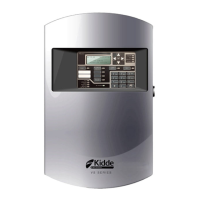Chapter 2: Front panel programming
P/N 3102351-EN • REV 005 • ISS 28DEC18 123
4. Choose the desired Loop Uncfgrd Alarm. (Loops 2 through 4 options are displayed only if
you have more than one loop).
5. Choose Correlation Groups and enter the number of the correlation group.
6. Press Enter to toggle between possible values:
To add the event to the group, choose Included.
— or —
To remove it from the group, choose Excluded.
7. Repeat steps 7 to 9 to add or remove the event from any remaining correlation groups to
be configured.
8. Choose Save.
9. Choose Event Notification.
10. Choose Active.
11. Configure active event notification. (Not all the options shown here are displayed on all
systems.)
Printer: This controls whether event information is sent to the printer. Press Enter to toggle
between Yes and No.
Coder: Four-digit coded output that is played in response to alarm conditions (00-00-00-00
to 99-99-99-99).
Dialer options are listed below.
• Acct 1 & 2: Event information is sent to both dialer accounts
• Acct 1: Event information is sent to dialer account one
• Acct 2: Event information is sent to dialer account two
• None: Event information is not sent to the dialer.
CID: Contact ID event code (000 to 999).
NET (1-8): Yes or No. This controls whether event information is sent to the connected
network.
12. When you have finished, choose Save.
13. Press the Menu button to exit menu mode, or continue programming.
Common trouble event programming
The common trouble event can be assigned to a correlation group and turn on an output
device. When the common trouble is assigned to a correlation group, every output device in
the correlation group turns on. Event notification can also be programmed for the common
trouble.

